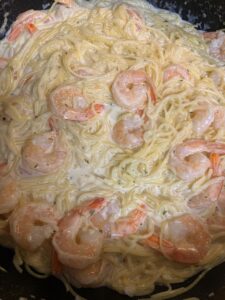
Elevate your dinner table with our irresistible Creamy Lemon Shrimp Pasta recipe. Bursting with vibrant citrus notes, succulent shrimp, and a luxuriously creamy sauce, this dish is a symphony of flavors that will delight your taste buds and leave you craving more.
Designed for both novice cooks and seasoned chefs, our recipe combines simple ingredients with easy-to-follow steps, ensuring a stress-free cooking experience without compromising on taste. From the perfectly al dente pasta to the tender, flavorful shrimp bathed in a velvety sauce, each element is meticulously crafted for culinary perfection.
Ingredients
- Pasta:
- 8 oz angel hair pasta
- Shrimp:
- 1 lb medium shrimp, peeled and deveined
- Cream Sauce:
- 2 cups heavy cream
- 1 cup chicken broth
- 2 tablespoons butter, divided
- 1 lemon, thinly sliced, plus more for garnish
- 2 cloves garlic, minced
- ½ teaspoon crushed red pepper flakes (adjust to taste)
- 1 teaspoon garlic and herb seasoning
- Salt, to taste
- Black pepper, to taste
- Garnish:
- Fresh parsley, chopped
Instructions
- Prepare Pasta:
- Bring a large pot of salted water to a boil.
- Cook the angel hair pasta according to package instructions until al dente.
- Drain and set aside.
- Cook Shrimp:
- Heat a large skillet over medium heat and add 1 tablespoon of butter.
- Once the butter is melted, add the shrimp, slices from half a lemon, minced garlic, garlic and herb seasoning, and red pepper flakes.
- Cook for 2-3 minutes or until the shrimp are pink and opaque. Remove the shrimp from the skillet and set aside.
- Make Cream Sauce:
- In the same skillet, add the chicken broth and let it simmer for a few minutes to reduce slightly.
- Add the remaining tablespoon of butter. Once melted, incorporate the heavy cream.
- Remove the cooked lemon slices and discard them.
- Let the sauce simmer gently to thicken slightly, about 5 minutes. Season with salt and black pepper to taste.
- Combine Pasta and Shrimp:
- Return the cooked shrimp to the skillet with the cream sauce.
- Add the drained pasta to the skillet and toss to coat evenly with the sauce.
- Allow the combined ingredients to simmer together for 2-3 minutes, so the flavors meld.
- Finish and Serve:
- Adjust the seasoning if necessary and add fresh lemon slices for extra zest.
- Garnish with chopped parsley.
- Serve hot, ensuring each plate has a good mix of shrimp, pasta, and creamy sauce.
Tips:
- Lemon Adjustment: The acidity and fragrance from the lemons can be adjusted based on your taste preference. Adding more slices while cooking can intensify the lemon flavor.
- Sauce Consistency: If the sauce is too thick, you can thin it with a little more chicken broth or pasta water. If too thin, let it simmer longer or add a slurry of cornstarch and water.
- Herb Variations: Feel free to experiment with different herbs such as basil or thyme if garlic and herb seasoning isn’t your preference.
Why You’ll Love it:
You’ll love this Creamy Lemon Shrimp Pasta for several reasons:
- Bright, Zesty Flavor: The combination of fresh lemon slices and minced garlic infuses the dish with a vibrant, zesty flavor that cuts through the richness of the creamy sauce, adding a refreshing tanginess to every bite.
- Creamy Indulgence: The luxurious cream sauce, made with heavy cream and chicken broth, creates a velvety texture that coats each strand of pasta and perfectly complements the tender shrimp, providing a satisfyingly creamy indulgence.
- Balanced Seasoning: The blend of garlic and herb seasoning, crushed red pepper flakes, salt, and black pepper adds layers of savory, spicy, and herbal notes, ensuring a well-balanced and flavorful dish that tantalizes your taste buds.
- Quick and Easy: With simple ingredients and straightforward steps, this recipe is easy to follow and perfect for busy weeknights or lazy weekends when you crave a delicious homemade meal without spending hours in the kitchen.
- Customizable: You can easily customize this recipe to suit your preferences by adjusting the amount of lemon, garlic, seasoning, or spice according to your taste. Plus, you can add extra ingredients like vegetables or herbs to elevate the dish even further.
- Restaurant-Quality Results: Despite its simplicity, this Creamy Lemon Shrimp Pasta delivers restaurant-quality taste and presentation that will impress your family and friends, making it a go-to recipe for both casual dinners and special occasions.
How to store it:
Storing Creamy Lemon Shrimp Pasta properly ensures it stays fresh and maintains its flavors. Here’s how to do it:
- Refrigeration: Allow the pasta to cool completely at room temperature before storing it. Once cooled, transfer the pasta and sauce into an airtight container or a sealable plastic bag. Ensure that the container is tightly sealed to prevent any air from entering, which could cause the pasta to dry out.
- Labeling: Label the container with the date of preparation to keep track of its freshness. Creamy dishes like this are best consumed within 3-4 days when stored in the refrigerator.
- Avoid Overcrowding: Store the pasta in a single layer if possible to prevent it from sticking together. If you need to stack the pasta, place a layer of parchment paper or plastic wrap between the layers to prevent them from sticking.
- Reheating: When you’re ready to enjoy the leftover Creamy Lemon Shrimp Pasta, you can reheat it on the stovetop or in the microwave. If reheating on the stovetop, add a splash of chicken broth or water to the skillet to help revive the creamy sauce. Heat gently over medium-low heat until warmed through, stirring occasionally to prevent sticking. If using the microwave, cover the container loosely with a microwave-safe lid or paper towel to prevent splattering, then heat in 30-second intervals until heated to your desired temperature.
-
Quality Check: Before consuming reheated pasta, check its aroma, texture, and appearance. If it smells off, has an unusual texture, or shows signs of spoilage such as mold, it’s best to discard it.



